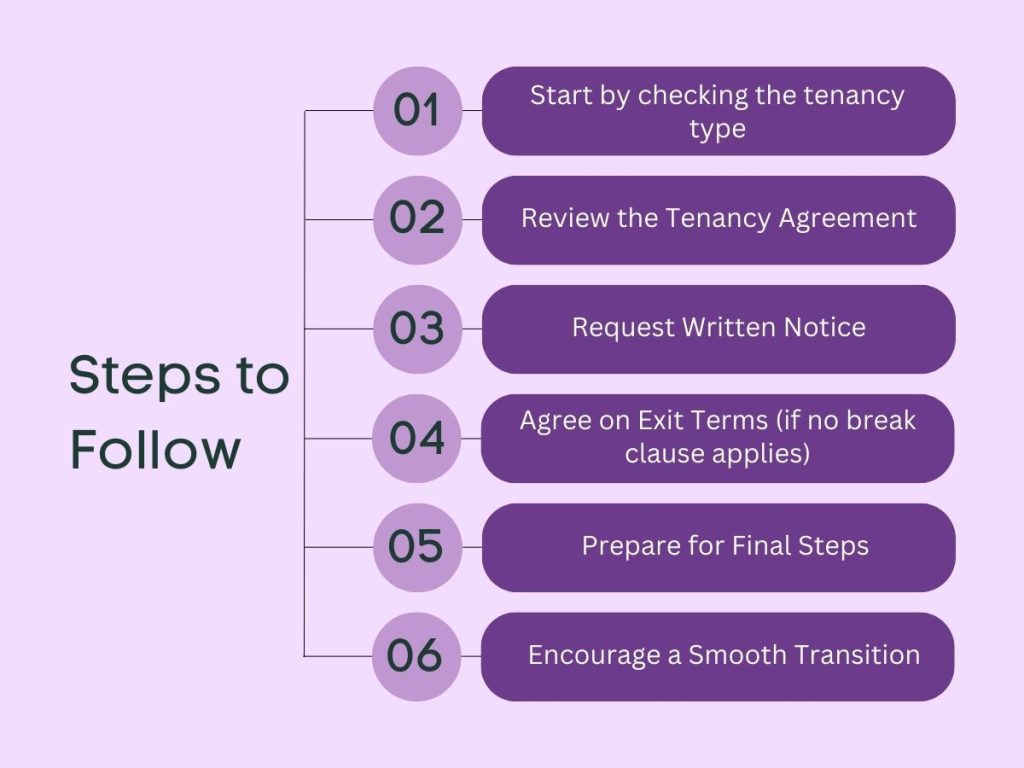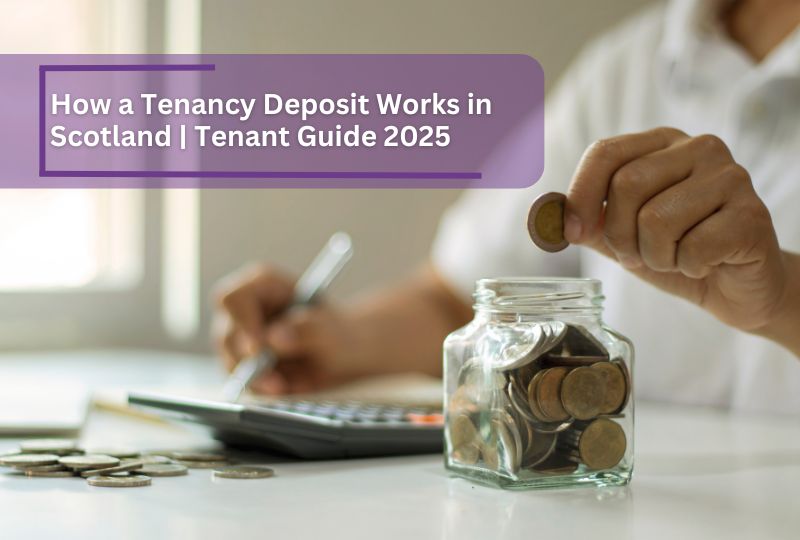When managing a property in Scotland or elsewhere in the UK, situations arise where a tenant wants to leave before the tenancy ends. This may be due to personal issues, job changes, disputes, or even misunderstandings about landlord-tenant law. In these moments, tenants often ask, “Can the tenancy be ended before the contract ends?” or “How do I get out of a tenancy agreement?”
The good news is that the answer is yes, but it depends on whether your tenancy agreement includes a break clause or if the landlord has breached the terms of the agreement. In Scotland, especially, under the Private Residential Tenancy (PRT) system, there are clear regulations outlining the notice period required, the proper procedures for ending the tenancy, and the rights and responsibilities of both parties involved.
In this guide, we’ll walk you through exactly what happens when a tenant wants to leave before the end of a contract, focusing on Scotland’s unique laws, covering everything from the notice period and how to end the tenancy properly to handling rent arrears and situations involving joint tenancies.
Understanding Different Types of Tenancy & Agreements

The first step in handling an early termination of tenancy request is identifying the type of agreement in place. A tenancy agreement outlines both parties’ rights and responsibilities, so reviewing it carefully helps you understand what options are available. The terms of the contract can significantly affect how early termination is handled.
1. Private Residential Tenancy (PRT):
For tenants who moved in after 1 December 2017, their agreement is usually a Private Residential Tenancy (PRT). These tenancies don’t have a set end date and continue until either the tenant or landlord decides to end them. Tenants can leave by giving at least 28 days’ written notice, but they remain responsible for paying rent right up to their departure, including any outstanding rent arrears.
2. Short Assured Tenancy(SAT):
Tenancies that began before 1 December 2017 are often Short Assured Tenancies (SATs) with fixed terms, such as six months or a year. Tenants cannot leave early unless a break clause is included or both the landlord and tenant agree to end the tenancy.
3. Fixed-Term Tenancy:
Fixed-term tenancies, such as six or twelve months, bind both landlord and tenant for the agreed period. If the tenant signed the agreement and decides to leave early without a valid reason or your consent, they can be held responsible for paying rent until the end of the term or until a replacement tenant is found.
4. Periodic Tenancy:
A periodic tenancy continues on a weekly or monthly basis. Tenants can leave more easily, but they must provide notice that matches their rental period (e.g., one month’s notice for a monthly tenancy).
5. Joint Tenancy:
In a joint tenancy, all tenants share responsibility for the rent and the lease terms. If one tenant wishes to leave early, the remaining tenants (or the landlord) must typically cover the rent. The tenant leaving may still be liable for rent until a replacement tenant is found.
6. Lodger or Occupant Situations
A lodger lives with the landlord and usually has more flexible terms compared to full tenants. An occupant may have even fewer rights depending on the agreement. These distinctions matter because rights to early termination differ significantly.
Leaving a Tenancy Early: What Landlords Need to Know
If your tenant says they want to move out early, whether they’re on a fixed-term, periodic, or Private Residential Tenancy (PRT), it’s important to understand the process and legal implications for each type. Here’s what you need to know based on the kind of tenancy they have:
1. Leaving a Fixed-Term Tenancy Early (or SAT):
As a landlord, if your tenant is in a fixed-term tenancy (e.g., 6 or 12 months), they cannot simply leave before the end of the term without consequences. Here are the main options and your rights:
a. Break Clause
Check the tenancy agreement for a break clause, which lets either party end the tenancy early after a specified period, often six months in a 12-month contract. Using a break clause is the most straightforward way for tenants to request early lease termination.
- Notice Requirements: Tenants usually need to give one or two months’ notice, as specified in the agreement.
- Failure to Follow Procedure: If the tenant fails to give appropriate notice, you may apply for a court order to recover any lost rent or enforce the tenancy agreement.
Example: If a tenant has a 12-month contract with a break clause allowing them to leave after six months, they could give notice at month four and vacate by the end of month six.
b. Mutual Agreement with the Landlord
If the tenancy doesn’t include a break clause, tenants can request whether you’re willing to agree to end the tenancy early by mutual agreement. This type of tenancy is known as “surrendering” tenancy.
- Written Agreement: If you agree, formalise the decision in writing to avoid disputes.
- Compensation: While you’re not legally required to agree to early termination, you can negotiate compensation or ask for rent payments until a replacement tenant is found.
- Re-letting: Consider whether a new tenant can be secured quickly to minimise void periods.
c. Assignment or Subletting
In some cases, tenants may ask to assign the tenancy to another person or sublet the property, while still being responsible for the tenancy. Tenants need your permission to assign or sublet the tenancy. Even if you allow subletting, the original tenant is still liable for the rent and any damages.
If none of the above options apply or are agreed upon, you can legally refuse the early exit and expect the tenant to pay rent for the remainder of the fixed term.
2. Leaving a Periodic Tenancy Early
Tenants on weekly or monthly tenancies can usually leave without much hassle, but they must give proper notice four weeks for weekly tenancies or a full rental period for monthly ones. If they fail to do so, you can recover unpaid rent or deduct costs from their security deposit.
- For a weekly tenancy, they need to submit a notice period of at least four weeks before.
- For a monthly tenancy, the tenant must give one full rental period’s notice (usually one month).
Example: If a tenant pays rent monthly, they would likely need to give one month’s notice. Their move-out date would typically fall on the day before their rent is due. Ensure they provide the correct notice to avoid complications.
3. Leaving a Private Residential Tenancy (PRT) Early
If your tenant is on a Private Residential Tenancy (PRT)—which applies to most tenancies that started on or after 1 December 2017—they have the legal right to end the tenancy at any time, provided they give you at least 28 days’ written notice.
Key Points for Landlords:
- No Permission Needed: Tenants do not need your approval to end the tenancy—they only need to notify you properly.
- Notice Format: Tenants can send the notice by letter, email, or through an agreed online method (e.g., through your letting agency’s portal).
- Required Details: The tenant should clearly state their intention to end the tenancy in their notice. It must include the tenant’s name, the full property address, and the start date of the tenancy. Additionally, the notice should specify the final day the tenant intends to pay rent and vacate the property. The tenant must sign and date the notice for it to be valid.
- Proof of Notice: Encourage tenants to keep proof of delivery (e.g., email confirmation, postal receipt), which can also benefit you in resolving disputes. Keeping clear written records can serve as evidence to support claims or agreements made with tenants.
- Rent Responsibility: If a tenant does not pay rent, you have the right to recover any outstanding rent arrears through legal channels.
Example: If a tenant serves notice on 1st May, the tenancy would legally end on 29th May.
6 Steps to Follow for Ending a Tenancy Contract in Scotland

Now that you understand the types of tenancies and when leaving early might be possible, let’s break down the actionable steps you need to follow when a tenant wants to end tenancy early.
1. Start by checking the tenancy type:
First, determine what type of tenancy your tenant has: PRT, SAT, fixed-term, or periodic. Tenants on a PRT can leave with 28 days’ notice. For older or fixed-term tenancies, check the rental agreement for any clauses allowing early termination. If no clause exists, you don’t have to agree, but you can discuss options like compensation or rent payments until a new tenant moves in.
2. Review the Tenancy Agreement:
When reviewing the tenancy agreement, look for any break clauses that may allow for early termination, the specific notice period requirements the tenant must follow, and any rules related to subletting or assigning the tenancy to someone else.
3. Request Written Notice:
Ensure the tenant provides a written notice that includes their full name, the property address, the start date of the tenancy, and the intended move-out date—this must be at least 28 days from the date of notice. If the notice is given by post, it should also be signed. Acceptable delivery methods include email (preferably with a read receipt), recorded postal delivery, or handing it over in person with confirmation of receipt.
4. Agree on Exit Terms (if no break clause applies):
When agreeing to an early termination, discuss the tenant’s rent obligations until a new tenant is found to cover the financial gap. You may also consider requesting compensation for the early exit, especially if it leads to unexpected costs or vacancy periods. Clearly outline expectations regarding the condition of the property, including thorough cleaning, addressing any damage, and ensuring all keys are returned by the agreed date to avoid disputes and delays in the transition process.
5. Prepare for Final Steps:
At the end of a tenancy, carry out a thorough inspection, comparing the property’s condition with the original inventory to identify any damage or cleanliness issues. Process the deposit refund through an approved Tenancy Deposit Scheme (TDS), and provide a clear breakdown of any deductions for repairs or cleaning. Ensure the keys are returned by the agreed deadline, and avoid entering the property without proper notice while the tenant is still living there.
6. Encourage a Smooth Transition:
Staying professional and responsive when a tenant wishes to end their tenancy early can significantly reduce friction and potential conflicts. Demonstrating flexibility during exceptional personal circumstances, such as redundancy, illness, or a relationship breakdown, not only fosters goodwill but can also help maintain a positive landlord-tenant relationship and minimise the likelihood of future disputes.
By following these steps, you’ll ensure a smooth process when ending your tenancy early and avoid complications with your landlord.
Joint Tenancy: What If Only One Person Wants to Leave?
When only one tenant in a joint tenancy wishes to leave, it’s important to handle the situation thoughtfully and clearly as a landlord. In a joint tenancy, all tenants are equally responsible for the rent and the terms of the agreement, so one person cannot unilaterally end the tenancy. If a tenant wants to move out while others stay, the law does not require you to release them from the agreement. but offering a reasonable solution can help maintain good relations. Here is what you can do:
- Allow a tenant swap if needed: If one tenant wants to leave, let the group know they can look for a suitable replacement with the agreement of all remaining tenants.
- Request housemate approval first: Ask the tenant to speak with their housemates to ensure they’re comfortable with someone new joining the tenancy.
- Approve the new tenant: Once tenants suggest a replacement, conduct your usual referencing and checks to ensure they meet your standards.
- Update the agreement: If everyone agrees, either amend the current tenancy or create a new agreement reflecting the change — all parties should sign.
- Keep documentation clear: Document everything in writing, including the outgoing tenant’s release and the incoming tenant’s responsibilities.
- Support a smooth transition: Stay flexible and communicative — it helps maintain good relationships and keeps the tenancy running without disruption.
How Long Does Referencing Take for New Tenants?
Once your outgoing tenant has given notice, you can begin searching for a replacement tenant. Tenant referencing typically takes between 24 to 72 hours, depending on:
- Employer and previous landlord response times
- Credit checks
- Right to Rent verifications (in England only)
To minimise void periods, it’s wise to start marketing the property early, ideally as soon as you receive the formal notice. This proactive approach will help ensure you secure a new tenant quickly and reduce any potential gaps in rental income.
What Happens If the Tenant Leaves Without Notice?
In Scotland, not giving proper notice when ending a tenancy can lead to serious legal and financial consequences. Here’s a clear breakdown of what could happen if tenants don’t follow the correct notice process:
- Recover Rent Arrears: Charge rent for the notice period (typically 28 days for a Private Residential Tenancy).
- Deduct from Deposit: Use the tenant’s deposit to cover unpaid rent or damages.
- Avoid Re-letting or Entering the Property: Do not re-let or enter the property until the tenancy is legally terminated.
- Legal Action: If the tenant refuses to pay, you may need to take legal action to recover lost rent.
- Joint Tenancy: If in a joint tenancy, the remaining tenants may have to cover the missing tenant’s rent and could face difficulties removing their name from the agreement.
- Utility Bills & Council Tax: The tenant could still be liable for any outstanding bills or council tax, though students may qualify for exemptions.
Conclusion:
When a tenant wants to leave early, there are clear procedures and rules in place that protect both the tenant and the landlord. As a landlord, it’s essential to know your rights and obligations and ensure that you handle early terminations with understanding, fairness, and in compliance with Scottish tenancy laws. By reviewing the tenancy agreement, ensuring proper notice is given, and considering your options for replacement tenants, you can navigate this process smoothly.
If you want expert guidance or support with any tenancy issue, Westport Property is here to help. Our team can advise on the correct procedures, help manage early terminations, and ensure everything is handled efficiently and legally. Contact us today to get advice tailored to your situation and make managing your tenancy hassle-free.
Have A Question or Need Some Help?
Whether you're searching for the perfect rental property or a landlord wanting advice on letting, we're here to assist. Feel free to call our office or send us an email, and we'll be happy to help you with any queries you may have.
FAQs:
What happens if a tenant leaves without giving notice during a fixed-term tenancy?
If a tenant leaves without notice, they remain liable for rent until the end of the fixed term or until a new tenant is found. The landlord can pursue rent arrears or deduct unpaid rent from the deposit.
Can a landlord charge a tenant for re-letting costs if they leave early?
No, landlords in Scotland cannot charge re-letting fees like advertising or agent costs under the Private Housing (Tenancies) (Scotland) Act 2016. Only rent and refundable deposits (up to two months’ rent) are allowed. If both parties agree to an early lease termination, landlords may claim actual losses—but only if this is clearly stated in writing. Tenants can challenge unfair charges at the First-tier Tribunal (Housing and Property Chamber).
Are tenants still liable for council tax after leaving early?
Yes, tenants are responsible for council tax until the tenancy legally ends. If the tenant vacates early without the landlord's agreement, the council tax liability usually continues until a new tenant moves in or the contract expires.
Can a tenant use a break clause at any time during the tenancy?
No, break clauses can only be used after the conditions within the clause are met, often after 6 or 12 months. The tenant must also provide the required notice as specified in the contract.
How can tenants protect themselves when leaving early due to personal hardship?
Tenants should communicate with the landlord in writing and provide evidence of hardship. In some cases, landlords may agree to early termination, especially if a replacement tenant is offered or hardship is demonstrable.
What happens if a tenant builds up rent arrears before the end of the tenancy?
If a tenant falls into rent arrears, they remain legally liable for the unpaid amount until the debt is cleared or the tenancy ends. Landlords can issue a Notice to Leave and, if unresolved, may pursue repayment through legal channels, including the First-tier Tribunal.
Can a landlord begin court proceedings if a tenant leaves early without agreement?
Yes, if a tenant abandons a tenancy without mutual agreement or proper notice, the landlord can initiate court or tribunal proceedings to recover unpaid rent or damages. Evidence of breach and reasonable mitigation efforts are typically required.
What are legitimate reasons to break a lease?
In Scotland, a tenancy can only end early through mutual agreement, a break clause (if included in older agreements), or when a statutory ground for eviction applies, such as rent arrears, antisocial behaviour, the landlord needing to sell, or the landlord needing to move back in. Outside of these situations, neither party can simply walk away without following the legal process.
What is the early termination clause for landlord?
For modern Private Residential Tenancies (PRTs), there is no traditional early-termination clause. Landlords must serve a Notice to Leave and rely on one of the legally recognised eviction grounds, with the correct notice period (28 or 84 days). Early-termination clauses exist only in older tenancy types, not in new PRTs.
Do landlords generally prefer fixed-term or periodic (rolling) tenancy agreements and why?
Scotland uses open-ended PRTs, which function like rolling tenancies. Fixed-term agreements are no longer used for new private tenancies. This open-ended model is generally preferred because it reduces renewal admin and still allows landlords to end the tenancy when a valid eviction ground applies.



 Find a Property Sale/Rent
Find a Property Sale/Rent  Letting Agents
Letting Agents  Asset Management
Asset Management 






